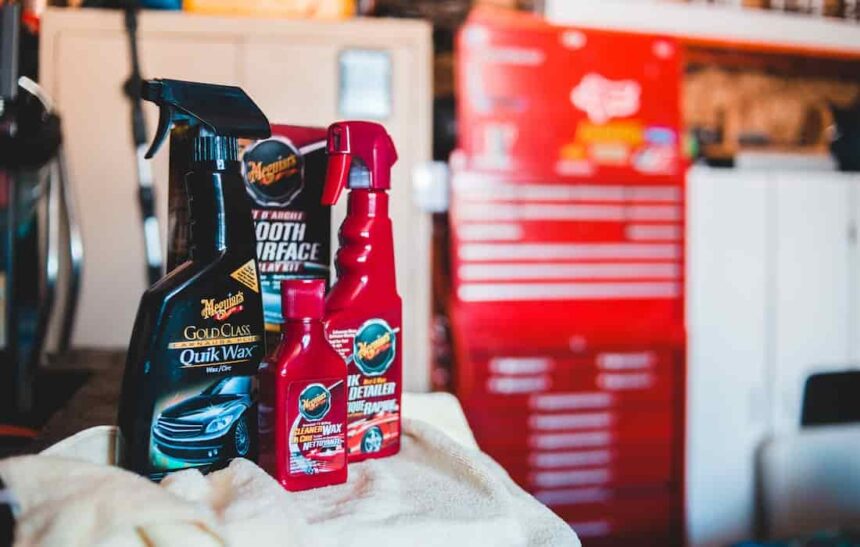Car detailing is the process of cleaning and restoring a vehicle to its original condition. It involves various steps, such as washing, drying, polishing, and waxing. While car wax and car polish are often used interchangeably, they are two distinct products with different purposes and functions. In this article on IchieTech, we will explore the differences between car wax and car polish and explain how they contribute to the overall appearance and protection of a vehicle.
Car Wax
Car wax is a protective coating that is applied to a vehicle’s exterior to provide a layer of protection against environmental factors such as UV rays, rain, and dirt. It also works by filling in small scratches and imperfections on the surface of the paint, creating a smooth and shiny finish. There are two types of car wax: natural and synthetic.
Natural car wax is made from natural ingredients such as carnauba wax, beeswax, or natural oils. It is known for providing a warm, deep shine and lasting longer than synthetic wax. However, natural wax is more expensive and can be harder to apply.
Synthetic car wax, on the other hand, is made from chemicals and polymers. It is easier to apply and can provide a longer-lasting shine than natural wax. However, synthetic wax may not provide the same depth of shine as natural wax.
Pros and Cons of Car Wax
Pros:
- Protection: Car wax provides a protective layer that can help shield a car’s paint from environmental factors such as UV rays, rain, and dirt. This can help prevent paint damage and preserve the car’s appearance over time.
- Shine: Car wax can help enhance a car’s shine, making it look more vibrant and new.
- Water repellent: Car wax can make a car’s surface more water-repellent, which can help prevent water spots and streaks.
- Easy to apply: Car wax is relatively easy to apply and doesn’t require any special tools or equipment.
Cons:
- Time-consuming: Applying car wax can be time-consuming, as it requires washing and drying the car before application, and then waiting for the wax to dry and buffing it off.
- Short-lived: Car wax typically needs to be reapplied every few months in order to maintain its effectiveness, which can be inconvenient for some car owners.
- Limited protection: While car wax provides some protection against environmental factors, it may not be enough to fully protect a car’s paint in harsh conditions.
- Cost: High-quality car wax can be expensive, which can be a deterrent for some car owners.
While car wax can provide a protective layer and shine to a vehicle’s exterior, it does not have any cleaning or polishing properties. It is simply a protective layer.
Also read:
Car Polish
Car polish is a product that is used to remove imperfections from a vehicle’s paint, such as swirl marks, scratches, and water spots. It works by using abrasive particles to smooth out the surface of the paint and create a reflective shine. There are two types of car polish: abrasive and non-abrasive.
Abrasive car polish contains small particles of abrasive material, such as aluminium oxide, that remove a thin layer of the clear coat on the paint. It is designed to remove deeper scratches and imperfections. Non-abrasive car polish, also known as “glaze,” uses chemical cleaners to remove minor imperfections and stains from the paint.
Pros and Cons of Car Polish
Pros:
- Shine: Car polish can help enhance the shine of a car’s paint, making it look new and vibrant.
- Smoothing: Car polish can help smooth out minor imperfections in a car’s paint, such as swirl marks or minor scratches.
- Protective: Some car polishes contain protective ingredients that can help shield a car’s paint from environmental factors, such as UV rays, dirt, and debris.
- Easy to apply: Car polish is relatively easy to apply and doesn’t require any special tools or equipment.
Cons:
- Time-consuming: Applying car polish can be time-consuming, as it requires washing and drying the car before application, and then waiting for the polish to dry and buffing it off.
- Short-lived: Car polish typically needs to be reapplied every few months in order to maintain its effectiveness, which can be inconvenient for some car owners.
- Limited protection: While some car polishes offer protective properties, they may not be enough to fully protect a car’s paint in harsh conditions.
- May not be suitable for all types of paint: Some car polishes may not be suitable for certain types of paint or finishes, and may even cause damage.
Car polish is used to create a smooth and reflective surface on a vehicle’s paint. It does not provide any protection against environmental factors like car wax.
Differences between Car Wax and Car Polish
The main difference between car wax and car polish is their chemical composition and purpose. Car wax is a protective coating that fills in minor scratches and provides a layer of protection against environmental factors. Car polish, on the other hand, is an abrasive or chemical product that removes imperfections from the paint and creates a smooth and reflective surface.
The application method for car wax and car polish also differs. Car wax is applied in a thin layer using a soft cloth or applicator pad. It is then allowed to dry and buffed off with a microfiber towel. Car polish, on the other hand, is applied in a similar manner but requires more elbow grease to work the abrasive particles into the surface of the paint. The results and benefits of car wax and car polish also differ.
Car wax provides a protective layer that repels water, dirt, and UV rays. It also provides a glossy finish that can last for several months. Car polish, on the other hand, creates a smooth and reflective surface that enhances the appearance of the paint. It can also remove minor imperfections and swirl marks that may be present on the surface.
Choosing between car wax and car polish depends on the condition of your vehicle’s paint and your desired results. If your paint is in good condition and you want to provide protection against environmental factors, car wax is a good choice. If your paint has imperfections and you want to create a smooth and reflective surface, car polish is the way to go.
How to Choose Between Car Wax and Car Polish
Car wax and car polish are two different products that serve different purposes. Car wax is used to protect the paint and add shine, while car polish is used to remove scratches and restore the shine of the paint. Here are some factors to consider when choosing between car wax and car polish:
- Condition of the paint: If the paint on your car is in good condition, meaning it has no visible scratches, swirl marks, or other imperfections, then car wax is the better choice. Wax will add a layer of protection to the paint and give it a glossy shine.
- Age of the car: If your car is relatively new, car wax is a good choice because it will help protect the paint from environmental factors such as UV rays, acid rain, and bird droppings. If your car is older and has visible scratches, swirl marks, or other imperfections, then car polish is a better choice because it will help remove these imperfections and restore the shine of the paint.
- Time and effort: Applying car polish requires more time and effort than applying car wax. Car polish requires multiple steps, including buffing, to achieve the desired result. Car wax, on the other hand, is much easier to apply and can be done in a matter of minutes.
- Type of paint: Different types of paint may require different types of products. For example, if you have a clear coat on your car, then car wax is a good choice because it will protect the clear coat and give it a glossy shine. If your car has a single-stage paint job, then car polish is a better choice because it will help restore the shine of the paint.
Conclusion
In conclusion, car wax and car polish are two different products with different purposes and functions. Car wax provides a protective layer that fills in minor scratches and provides a glossy finish, while car polish removes imperfections and creates a smooth and reflective surface. Choosing between car wax and car polish depends on the condition of your vehicle’s paint and your desired results. Regardless of which product you choose, regular detailing is essential to maintain the appearance and value of your vehicle.










